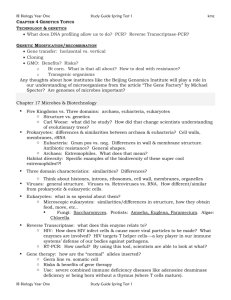Dr. Rachel Whitaker
advertisement
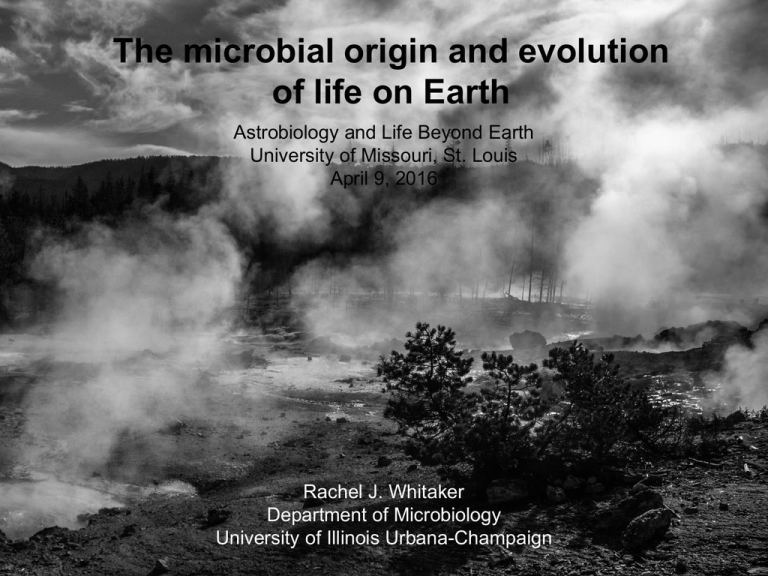
The microbial origin and evolution of life on Earth Astrobiology and Life Beyond Earth University of Missouri, St. Louis April 9, 2016 Rachel J. Whitaker Department of Microbiology University of Illinois Urbana-Champaign Earth is a microbial world You are here Pace, Science 1997 Archaea From: Brock: Biology of Microorganisms Archaea From: Brock: Biology of Microorganisms Archaea From: Brock: Biology of Microorganisms The greatest pollution event Archaea From: Brock: Biology of Microorganisms Archaea From: Brock: Biology of Microorganisms Archaea From: Brock: Biology of Microorganisms Highly reduced/no oxygen Archaea Chemotrophic primary productivity without light From: Brock: Biology of Microorganisms Insight: Carl R. Woese to Francis Crick 1969 Mapping the tree of life Molecular fossils 23S rRNA 16S/18S rRNA The Ribosome What did cellular life look like in the beginning? Woese, C R, and G E Fox. “Phylogenetic Structure of the Prokaryotic Domain: The Primary Kingdoms.” Proceedings of the National Academy of Sciences of the United States of America 74, no. 11 (November 1977): 5088–90. TheMicrobial Microbial Cell Cell Chromosome Motility and environment interaction DNA Chromosome Transcription DNA->RNA Ribosome Translation RNA-> protein Membrane Identify components shared by different What Components Are Universal? Map characters onto the tree of life to see what was shared by the common ancestors Metabolism Most negative strongest donors Methanosarcina mazei Desulfovibrio vulgaris Shewanella oneidensis You Most positive strongest acceptors Electron transport chain makes a gradient E (V) 0 0.22 ENVIRONMENT 0.0 0.1 CYTOPLASM 0.36 0.39 E0(V) ATPase harvests the gradient ATP synthase Flexible enzyme for energy generation depends upon a cell The Cell Threshold Lipid Bilayer And Cell Membrane Genome Replication And Chromosome Structure DNA polymerases, initiation of replication Transcription Other DNA-dependent RNA polymerase subunits and initiation complexes Transcription 2 subunits of DNA-dependent RNA polymerase subunits Translation rRNA, tRNAs, elongation factors, tRNA charging enzymes, most (but not all) ribosomal proteins TheMicrobial Microbial Cell Cell Chromosome Motility and environment interaction DNA Chromosome Transcription DNA->RNA Ribosome Translation RNA-> protein Membrane ATPase and some way to make proton motive force Changes in Evolutionary Mode fossils 3.5 bya 4.5 bya Before 3.5 billion there must have been a difference in either tempo or mode Woese, C. R., and G. E. Fox. “The Concept of Cellular Evolution.” Journal of Molecular Evolution 10, no. 1 (September 20, 1977). The Progenote Vertical decent Progenote Communal evolution Woese, C. R., and G. E. Fox. “The Concept of Cellular Evolution.” Journal of Molecular Evolution 10, no. 1 (September 20, 1977). Evolutionary Mode Of The Progenote • The progenote was in the process of evolving the relationship between genotype and phenotype. • No individual cells, instead “supermolecular aggregates” with communal sharing of genetic material. • Sharing mode allowed a faster tempo and resulted in the rapid generation of complex molecular machines for translation and energy production. • Communal mode is ongoing if limited by vertical predominance of vertical evolution. Woese, C. R., and G. E. Fox. “The Concept of Cellular Evolution.” Journal of Molecular Evolution 10, no. 1 (September 20, 1977). Vetsigian, K., C. R. Woese, and N. Goldenfeld. “Collective Evolution and the Genetic Code.” Proc Natl Acad Sci USA 103 (2006): 10696–701. Viruses …the next frontier Archaea Eucarya Bacteria We need a new lens for population genetic analysis Whitaker Lab Members David Krause Maria Bautista Dr. Changyi Zhang Whitney England Samantha Dewerff Elizabeth Rowland Ted Kim Yueheng Zhou Jesse Black Former Lab Members Dr. Rika Anderson Dr. Nicholas Youngblut Dr. Nicole L. Held Dr. Hinsby Cadillo-Quiroz Dr. Kim Milferstedt Dr. Angela Kouris Michael Reno Collaborators Mark Young (Montana State) Kate Campbell (USGS) D. Kirk Nordstrom (USGS)


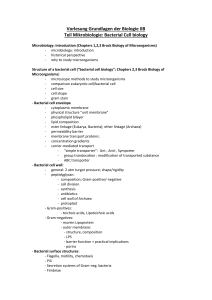
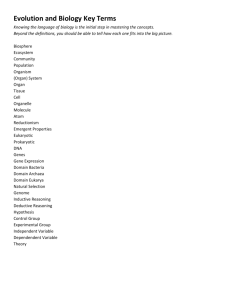
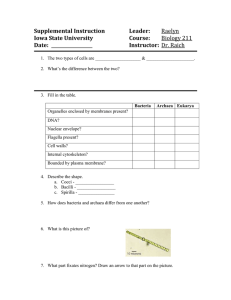

![Cell Game Board [10/16/2015]](http://s3.studylib.net/store/data/007063627_1-08082c134bbc8d8b7ad536470fbed9dc-300x300.png)
